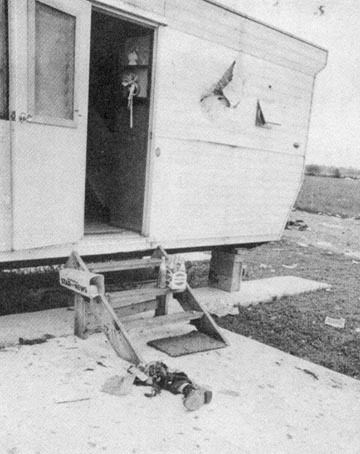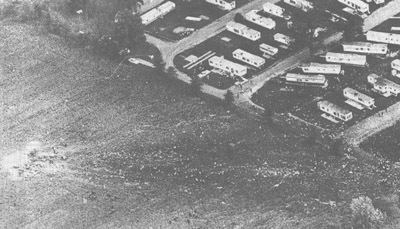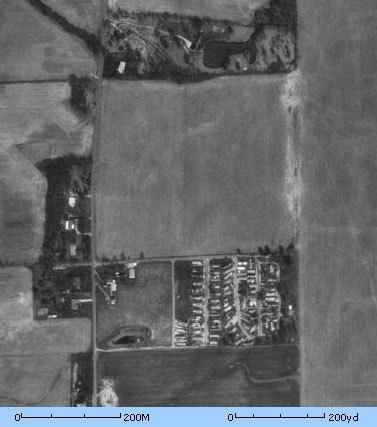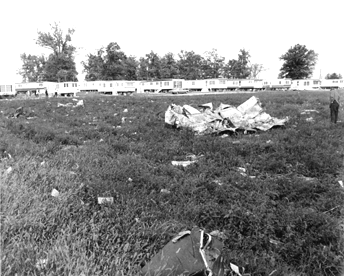Registration N988VJ Date 9 September 1969 Total survivors 0 | Total fatalities 83 | |
 | ||
Destination Lambert–St. Louis International Airport Similar Mexicana Flight 704, 1969 Aswan Ilyushin Il, Air France Flight 212, Hawthorne Nevada Airlines Fl, Viasa Flight 742 | ||
Allegheny airlines flight 853 crash site evps
On September 9, 1969, Allegheny Airlines Flight 853, a McDonnell Douglas DC-9 passenger jet, collided in mid-air with a Piper PA-28 light aircraft near Fairland, Indiana, United States. The DC-9 was carrying 78 passengers and 4 crew members. The Piper was leased to a student pilot on a solo cross-country flight. All 83 occupants of both aircraft were killed in the accident and both aircraft were destroyed by the collision and ground impact.
Contents
- Allegheny airlines flight 853 crash site evps
- Nbc report allegheny airlines flight 853 crash
- Flight history
- Witness reports
- Probable cause
- Legacy
- References

Nbc report allegheny airlines flight 853 crash
Flight history

Allegheny Airlines Flight 853, a DC-9-31, registration N988VJ, was a regularly scheduled flight departing Boston, Massachusetts, for St. Louis, Missouri, with stops in Baltimore, Cincinnati and Indianapolis. Captain James Elrod (47) and First Officer William Heckendorn (26) were at the controls. Elrod was a seasoned veteran, with more than 23,800 flight hours. The young co-pilot had accumulated close to 3,000 flight hours. The flight departed Cincinnati at 3:15pm en route to Indianapolis. Allegheny 853, flying under instrument flight rules (IFR) clearance to Indianapolis, was instructed by Indianapolis Approach Control to descend to 2500 feet after passing the Shelbyville VOR at 6000 feet. The flight was then vectored to a 280 degree heading.

Meanwhile, the private Piper PA-28, registration N7374J, piloted by Robert Carey (34), was on a southeasterly heading. It was operating under a filed visual flight rules (VFR) flight plan which indicated a cruising altitude of 3500 feet. The PA-28 was not in communication with Air Traffic Control, and was not transponder equipped, and there was no evidence it appeared as a primary radar target on the radarscope.
Witness reports

Eight witnesses saw the aircraft collide. They reported broken to scattered cloud cover in the area, but both aircraft were below the clouds and could be seen clearly at the time of the collision. According to the witnesses, neither aircraft attempted a collision avoidance maneuver. Wreckage analysis later concluded the PA-28's left forward side just forward of the left wing root clipped the DC-9's upper right vertical tail severing the horizontal stabilizer.

The PA-28 was struck by the DC-9 at a speed of roughly 350 mph (560 kph) and was sliced in half by the vertical stabilizer, which ripped straight through the cabin and killed the small plane's pilot instantly. Most of the PA-28 immediately plummeted to earth along with the airliner's vertical stabilizer, but the other third of it still had some momentum left and landed a few hundred feet further away. Meanwhile, the crippled DC-9 pitched over on its back and fell inverted into a soybean field at speeds exceeding 400 mph (640 kph). Some witnesses claimed it was spinning as it went, but the NTSB investigators disputed these assertions. Flight 853 was shattered to pieces, the wreckage scattered over half a mile. The passengers and crew were dismembered by the forces of impact, with no intact bodies found (although the PA-28 pilot's body was intact) Despite all this, there was no fire or explosion because impact speeds were so great that the DC-9's fuel load dispersed quickly and did not ignite.
Probable cause
The National Transportation Safety Board in a report adopted July 15, 1970, released the following Probable Cause:
The Board determines the probable cause of this accident to be the deficiencies in the collision avoidance capability of the Air Traffic Control system of the Federal Aviation Administration in a terminal area wherein there was mixed instrument flight rules (IFR) and visual flight rules (VFR) traffic. The deficiencies included the inadequacy of the see-and-avoid concept under the circumstances of this case; the technical limitations of radar in detecting all aircraft; and the absence of Federal Aviation Regulations which would provide a system of adequate separation of mixed VFR and IFR traffic in terminal areas.
Legacy
After this and similar mid-air collisions and near misses, both the NTSB and FAA realized the inherent limitations of the "see and be seen" principle of air traffic separation in visual meteorological conditions, especially when aircraft of dissimilar speeds or cloud layers and other restrictions to visibility are involved. The following mitigating steps have since been taken:
